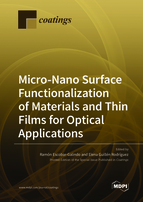Micro-Nano Surface Functionalization of Materials and Thin Films for Optical Applications
A special issue of Coatings (ISSN 2079-6412).
Deadline for manuscript submissions: closed (31 December 2020) | Viewed by 19748
Special Issue Editors
Interests: synthesis and characterization of nanostructured materials; design of solar selective coatings for energy applications; tuning optical properties of materials by controlling the microstructure; development of functional materials for additive manufacturing
Interests: coatings and nanostructured materials for solar energy applications, additive manufacturing, micro and nanofabrication, nanoimprint lithography, concentrating solar power, photoelectrochemical and spectroscopic characterization of photovoltaic devices
Special Issue Information
Dear Colleagues,
This Special Issue will provide a meaningful overview of recent advances and beyond the state of the art concepts regarding surface functionalization of materials and deposition of thin films to be used in optical applications. Our aim is to cover all relevant aspects of the topic (simulation, design, fabrication, characterization and applications) with a special emphasis on non-conventional methods for surface modification of materials. Design of hierarchical surface structures at different scale lengths, combination of mature fabrication routes with emerging technologies (i.e. additive manufacturing), and large area fabrication concepts, to pave the way to an industrial utilization of the developed materials, will be in the core of this volume.
In particular, the topics of interest of this Special Issue include, but are not limited to:
- Simulation of optical properties of micro and nano structures
- Modelling and design of micro/nano structures for optical applications
- Fabrication of optical structures and thin films using vacuum technologies (PVD, CVD, ALD, etc.)
- Fabrication of optical structures and thin films by non-vacuum and wet chemistry methods
- Emerging fabrication technologies for nano and micro optical structures (nanoimprint lithography, additive manufacturing, hybrid technologies etc.)
- Free form fabrication of nano and micro structures and thin films for optical applications
- Advanced optical characterization or nano and micro structures and thin films, including spatially-resolved, in-situ and in-operando techniques
- Nano and micro structures and thin films for ultra-broadband optical applications, light guiding and energy conversion
- New concepts for antireflective nano and micro structures and thin films
- Nano and micro structured metamaterial surfaces
- From lab to fab large area fabrication of nano and micro structures and thin films for optical applications
Dr. Ramón Escobar-Galindo
Dr. Elena Guillén Rodríguez
Guest Editors
Manuscript Submission Information
Manuscripts should be submitted online at www.mdpi.com by registering and logging in to this website. Once you are registered, click here to go to the submission form. Manuscripts can be submitted until the deadline. All submissions that pass pre-check are peer-reviewed. Accepted papers will be published continuously in the journal (as soon as accepted) and will be listed together on the special issue website. Research articles, review articles as well as short communications are invited. For planned papers, a title and short abstract (about 100 words) can be sent to the Editorial Office for announcement on this website.
Submitted manuscripts should not have been published previously, nor be under consideration for publication elsewhere (except conference proceedings papers). All manuscripts are thoroughly refereed through a single-blind peer-review process. A guide for authors and other relevant information for submission of manuscripts is available on the Instructions for Authors page. Coatings is an international peer-reviewed open access monthly journal published by MDPI.
Please visit the Instructions for Authors page before submitting a manuscript. The Article Processing Charge (APC) for publication in this open access journal is 2600 CHF (Swiss Francs). Submitted papers should be well formatted and use good English. Authors may use MDPI's English editing service prior to publication or during author revisions.
Keywords
- Nano-micro optical structures
- Optical thin films
- Metamaterials
- Advanced optical characterization
- Non-conventional, hybrid and large-area fabrication techniques







